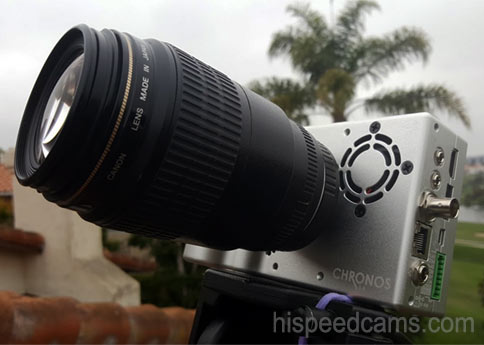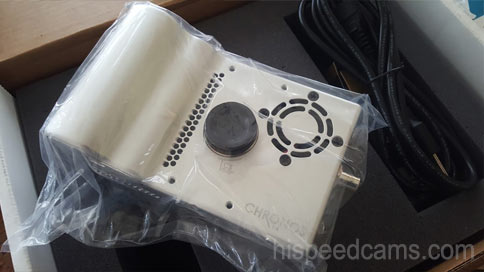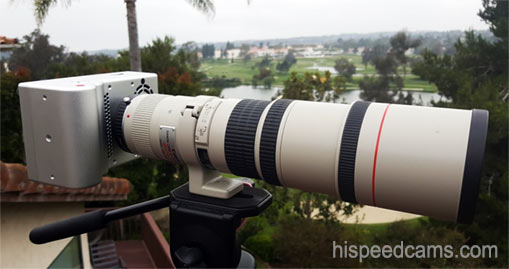Today we received the Chronos 1.4 camera from krontec.ca and we had just about 2 hours of overcast sunlight to give it a test drive. We have big expectations for this affordable slow motion Kickstarter project camera and will be putting it through its paces soon enough. We are sharing our first-day production camera test footage which you might find interesting.
We were able to adapt our Canon glass with the help of a C-Mount to EOS mount adapter and it really makes a difference in sharpness and glass quality compared to C-Mount lenses. Not to say that the kit lens is bad by any means but it is simply not to the standards of full frame legendary Canon glass. It is a big plus to be able to adapt almost any lens to the Chronos which opens up a lot of experimentation possibilities.
Lenses we tried today are the following:
- Canon EF 70-300 4-5.6 IS USM
- Canon 400mm L 5.6 Prime Lens
- Canon 100mm Macro USM
- Computar 12.5-75mm F/1.2 C-Mount Kit – Lens


There are a lot of good things to say about the camera like the tough all metal case, an assortment of IO ports, flawless recording, touch screen operation and lens adaptability among others. Our favorite feature so far is the ease of operation as recording on the field is simple and effective with in-out points to trim footage. The Codec in MP4 is hefty and does well with mild color grading.
There are a few quirks that have to be ironed out in software which we will try to help solve, and we are essentially testing the first production units along with other Kickstarter Early Bird backers. The camera can only improve from here and needless to say, it is quite good as first impressions go. See the footage below of our first day with the camera at 720p 1502fps.
Chronos 1.4 Production Footage Day 1:
You can get more information about the Chronos 1.4c camera at: http://www.krontech.ca/ – HSC


Nice footage! Is there a way you can post the original file here. Sometimes YouTube compressions makes the quality a bit worse.
We will share raw clips when the full review is out. We first have to know it’s limitations and strengths. The compression is very good but has a few sensor artifacts that can be fixed with a firmware update due to calibration issues. When those are fixed it will be better to share. The quality is much better than the Sony RX series at 480fps but this one does 1502fps.
Looking forward to the review.
I don’t know anything about the C-mount lenses, but your Canon zoom does 70 @ f/4 and the Computar 70 @ f/1.2 . This would theoretically mean the Computar lets in around 11 x the light allowing for faster, crisper exposures.
But you mention the Canon is full frame – is the Computar lens only using a portion of the lens, effectively making the f/1.2 something much slower and explaining why you are seeing crisper images from the Canons?
The computar is an ok lens at f3.5 and up but still a little dreamy. Light gathering has nothing to do with sharpness or chromatic aberration control which is what the comment was about. When you have enough light like the sun for example you can use slowerlenses but sharper. Both the 100mm macro an 400mm L primes are some of the sharpest lenses ever produced for the Canon EF mount. We will test many more lenses with the camera. The computar is good but dreamy at large apertures which negates the f 1.2 speed.
I was talking about the sharpness from reduced motion blur faster lenses theoretically allow. But I understand, the Computar’s *lens* sharpness at f/1.2 negates any benefit. Thanks for that – I’ll omit ordering the Computar with the camera and check out how things go with the 28-70 f/2.8L & 70-200 f/2.8L I already have.
You will do well with those lenses, the computar is not an image quality champ.
I am very interested in the results you achieved with the 100mm macro. I am an insect macro photographer and would love to get some slow motion macro video of certain behaviors. Were you able to get highly detailed video at close to 1:1 with the 100mm?
Any chance you could post some samples?
Thanks so much!
Yes, the small 2/3 sensor coupled with the Canon 100mm macro we were using makes a 2mm Ant fill the entire frame of video. It is an excellent way to study minute insects and their movements. We tried Ants a few days ago and they were so large that we had to go back a few inches to get them fully in frame. So yes 1:1 is possible with this sensor which in reality will be quite a big bigger than a 1:1 in an APS-C or Full Frame camera.
Thanks much for the feedback. Any chance you’d be willing to share a sample vid of the ants so I could get an idea of the quality possible from this setup?
My interest lies in insects mostly from 10-25mm. I’m guessing you’d need to back off a bit with the 100mm to get those in frame. Did you rely on natural light or was artificial lighting necessary?
What lens was your Chronos Moths and Butterflies vid shot with?
Thanks again and have a great day.
It was all on the 100mm 2.8 Canon EF USM. Will send you an email with a sample. For your use, it will do very well as the size is about 10x what the ants were. You will be surprised at the detail.